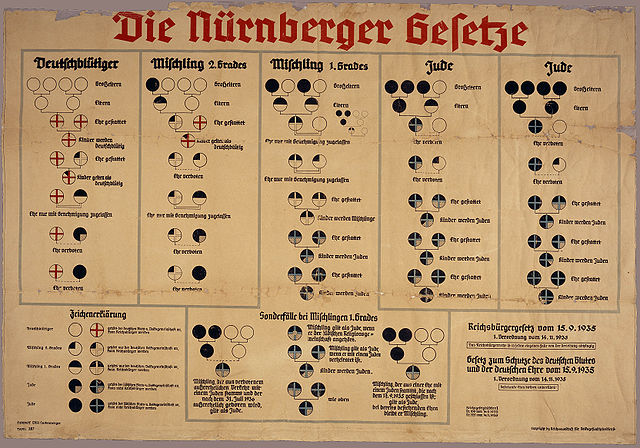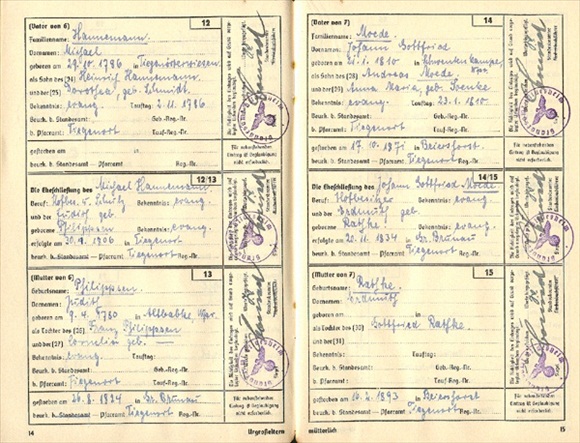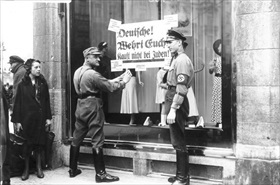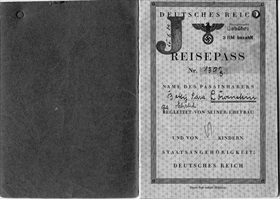U.S. MOB TRASHES NAZI FLAG, GERMAN CONSUL PROTESTS
New York City, New York • July 26, 1935
On this date in 1935 in New York Harbor, a group of anti-Nazi activists boarded the German passenger liner Bremen, tore from the ship’s jackstay the red, white, and black Nazi Party flag, its swastika emblazoned in the center, and pitched it into the Hudson River. When the German consul in New York City vigorously protested the flag’s desecration, U.S. officials responded that the German black, red, and gold national flag—the colors of the old Weimar Republic—had not been harmed, but only a political party symbol. On September 15, 1935, during a session of the Reichstag held in the walled, centuries-old German city of Nuremberg, where Nazi big-wigs and party members had opened their annual Party rally three days before, lawmakers remembered the New York outrage and declared the Nazi Party flag to be the national flag of Germany.
Of more significance was the Reichstag’s restrictive legal measures, known as the Nuremberg Laws, introduced at the 1935 Nuremberg party rally, a spectacle that mainly took place on a newly build reviewing stand and open-air stage at Zeppelin Field and which was choreographed and filmed by the talented movie actress, Leni Riefenstahl. (The film was the propaganda documentary Triumph des Willens, in English Triumph of the Will). One Nuremberg law, “The Law for the Protection of German Blood and Honor,” barred marriages and extramarital sex between “Germans” and “Jews” (Juden), the latter name now officially used in place of “non-Aryans,” and outlawed the employment of “German” females under the age of forty-five in Jewish households. Persons convicted of violating the law protecting German blood and honor faced hard labor, imprisonment with hard labor, and/or fines. (A secret decree in June 1937 stipulated that those guilty of “miscegenation” were to be sent to concentration camps following the completion of their sentence.) Another Nuremberg law, “The Reich Citizenship Law,” classified “Aryans” as Reichsbuerger (“Reich citizens”) and those not of “German or related blood” as “state subjects” (Staatsangehoerige) who henceforth lacked German citizenship rights.
The race laws were a legal embodiment of an already existing (since 1933) nationwide boycott of Jewish businesses and were tweaked numerous times from 1935 onward. For instance, in July 1935 Jews were “released” from the armed services and Jewish civil servants who had been protected by their status as World War I veterans were dismissed from public service. In 1938 a total Berufsverbot (“professional disqualification”) was extended to all academically trained Jewish professionals, and Jews had their state pensions reduced. The race laws progressively lessened the status and human dignity of members of the Jewish community in Germany and, after the 1938 Anschluss, in Austria as well.
![]()
Milestones on the Road to the Holocaust Began with Legally Marginalizing German Jews
 |
Above: The anti-Semitic Nuremberg Laws established a pseudoscientific basis for racial identification and with it state-sanctioned or state-sponsored social, political, and professional ostracism, harassment, and oppression. In their most warped and destructive form, Nazi racial laws eventually made it thinkable to murder 6 million people of Jewish ancestry on an industrial scale, quite apart from murdering millions of non-Germans. As shown in this chart from 1935, only people with four German grandparents (four empty circles in top row left) were of “German blood” (deutschbluetig) and thus Aryans. A Jew (Jude, pl. Juden) was someone who descended from three or four Jewish grandparents (black circles in top row right). Stranded in a racial no-man’s land between Jews and Aryans were “Jewish mixed-breeds” (Mischlinge) of the “first or second degree” (1 Grades, 2 Grades). A Jewish grandparent was defined as a person who is or was a member of a Jewish religious community. (Strangely, non-practicing Jews as most Mischlinge were raised to be, Christians who had converted to Judaism, and Jews who had converted to Christianity were all considered members of the Jewish religious community biologically and socially under the law.) The chart went on to list allowed marriages (“Ehe gestattet”) and forbidden marriages (“Ehe verboten”).
 |
Above: The pages in the Ahnenpass (Proof of Aryan Ancestry) documented the non-Jewish lineage of citizens of Nazi Germany and Austria. A proven Aryan lineage was required for working in the professions, attending high school or the university, owning real estate, and even getting married.
 |  |
Left: In a state-managed campaign, Nazi Stormtroopers (SA “brownshirt” thugs who numbered three million in 1934) affix a poster to the window of a Berlin store with the words “Germans! Defend yourselves! Do not buy from Jews!” (“Deutsche! Wehrt Euch! Kauft nicht bei Juden!”), April 1, 1933. Other signs included “Whoever Buys from Jews Is Stealing the Nation’s Assets” (“Wer beim Juden kauft stiehlt Volksvermoegen”), “The Jews Are Our Misfortune!” (“Die Juden sind unser Unglueck!”), and “Go to Palestine!” (“Geh nach Palaestina!”). German shopkeepers sometimes placed signs on their front doors, “Jews Not Welcome” (“Juden nicht erwuenscht”). Park benches bore labels “For Aryans Only” (“Nur fuer Arier”) and bathing beaches were touted as Judenfrei.
![]()
Right: German race laws required Jews to change their middle (second) name to “Israel” (male) or “Sara” (female) for use in all official communication and in legal and business documents. Portrait photographers, even Jewish ones, were kept busy producing photographs for the new ID cards. German passport holder Betty Sara Loewenstein, whose passport sprouted a large red “J” for “Juedin” (Jewish woman), was allowed to leave Germany but not return.
Photomontage of 1935 Nuremberg Nazi Party Rally and Its Outcome: The Nuremberg Race Laws (May want to mute the music)
![]()

 History buffs, there is good news! The Daily Chronicles of World War II is now available as an ebook for $4.99 on Amazon.com. Containing a year’s worth of dated entries from this website, the ebook brings the story of this tumultuous era to life in a compelling, authoritative, and succinct manner. Featuring inventive navigation aids, the ebook enables readers to instantly move forward or backward by month and date to different dated entries. Simple and elegant! Click
History buffs, there is good news! The Daily Chronicles of World War II is now available as an ebook for $4.99 on Amazon.com. Containing a year’s worth of dated entries from this website, the ebook brings the story of this tumultuous era to life in a compelling, authoritative, and succinct manner. Featuring inventive navigation aids, the ebook enables readers to instantly move forward or backward by month and date to different dated entries. Simple and elegant! Click 











